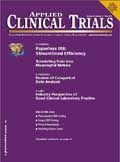Economic Squeeze Poses Threat to R&D
Applied Clinical Trials
Europe's financial problems have resulted in new blackslists of drugs among other challenges.
Financial pressures on healthcare systems appear to be having a growing impact on the European pharmaceutical sector, particularly in a largely state-run service like that in the United Kingdom.
General practitioners are being banned from prescribing high-cost drugs approved by the National Institute for Health and Clinical Excellence (NICE), and within the past year more than half of primary care organizations have brought in new blacklists of drugs that will not be funded by the National Health Service (NHS), according to a press release issued on April 13 by the UK-based news organization, Pulse.
"Restrictions often cover drugs approved by NICE or other national organizations, including gliptins for diabetes, denosumab for osteoporosis, atorvastatin, and rosuvastatin," the authors stated. "Other drugs have been blacklisted on the basis of 'low clinical priority,' including drugs for Parkinson's disease, newer contraceptive pills, erectile dysfunction drugs, some NSAIDs, the weight-loss drug orlistat, and homeopathic treatments."

Drugs on UK Primary CareOrganizations' Blacklists
Based on responses from 134 primary care organizations (PCOs)obtained under the Freedom of Information Act, primary care trusts and health boards are redrawing formularies in changes they estimate will cut £250 million (around $408 million) from this year's drug budget. A total of 73 PCOs said they had added drugs to blacklists or placed additional restrictions on prescribing in primary care during the past year. For a list of the range of products, see the table on right.
The long-term fear within the pharmaceutical industry is that such a trend will affect the future of research and development.
Further evidence of the current financial squeeze on the UK NHS is provided in a report published by the National Audit Office (NAO) on March 30. The lack of cohesion among NHS trusts (i.e., groups of hospitals) is wreaking havoc when it comes to purchasing, the report states. Trusts are unable to compare unit costs or efficiency because a repository of data does not exist, and managers have no way of comparing their trust's situation with that of others.
"The NHS faces the challenge to make better use of existing capacity in the current financial climate, as the government aims to deliver up to £20 billion of efficiency savings in the NHS by the end of 2014-15. Furthermore, in its 2010 Spending Review, the Government announced a 17 percent reduction in capital spending for the NHS over the next four years, from £5.1 billion in 2010-11 to £4.6 billion in 2014-15," noted the authors.
Around half of the UK's magnetic resonance imaging, computed tomography, and linear accelerator (linac) systems are due for replacement within the next three years, and 80 percent are due for replacement within six years, they continued. To replace existing machines, trusts would collectively have to find £460 million ($750 million) within three years and a further £330 million ($538 million) within six years. Some of this equipment has a role to play in drug development.
The number of CT and MRI examinations carried out for NHS patients has increased almost threefold in the past 10 years, while for linacs the number of radiotherapy treatment sessions has increased two-and-a-half-fold. By 2009, the activity levels for MRI and CT increased, virtually eliminating waits for scans of over six weeks, as part of the Department of Health's 18-week referral to treatment target. However, the percentage of people waiting under two weeks for referral for an MRI scan in 2009-10 varied between 20 percent and 93 percent. For CT scans, the percentage varied from 33 percent to 98 percent.
To find out more, you can download a free copy of the NAO report via this link: nao.org.uk/publications/1011/nhs_high_value_equipment.aspx.

Improving Relationships and Diversifying the Site Selection Process
April 17th 2025In this episode of the Applied Clinical Trials Podcast, Liz Beatty, co-founder and chief strategy officer, Inato, discusses a number of topics around site engagement including community-based sites, the role of technology in improving site/sponsor relationships, how increased operational costs are impacting the industry, and more.
Behind the Buzz: Why Clinical Research Leaders Flock to SCOPE Summit
February 7th 2025In this episode, we meet with Micah Lieberman, Executive Conference Director for SCOPE Summit (Summit for Clinical Ops Executives) at Cambridge Innovation Institute. We will dive deep into the critical role of collaboration within the clinical research ecosystem. How do we bring together diverse stakeholders—sponsors, CROs, clinical trial tech innovators, suppliers, patients, sites, advocacy organizations, investors, and non-profits—to share best practices in trial design, program planning, innovation, and clinical operations? We’ll explore why it’s vital for thought leaders to step beyond their own organizations and learn from others, exchanging ideas that drive advancements in clinical research. Additionally, we’ll discuss the pivotal role of scientific conferences like SCOPE Summit in fostering these essential connections and collaborations, helping shape the future of clinical trials. Join us as we uncover how collective wisdom and cross-industry partnerships are transforming the landscape of clinical research.
FDA-Approved Gene Therapy Beqvez Shows Sustained Efficacy, Safety in Long-Term Hemophilia B Trial
April 17th 2025Beqvez (fidanacogene elaparvovec), an FDA-approved one-time gene therapy for hemophilia B, demonstrated sustained factor IX expression, low bleeding rates, and a favorable safety profile over long-term follow-up.